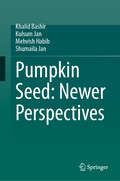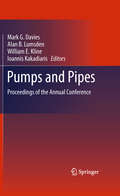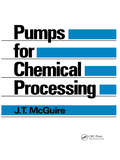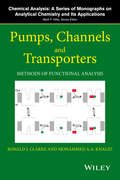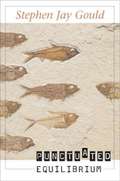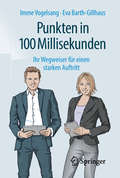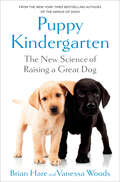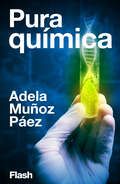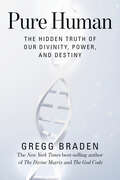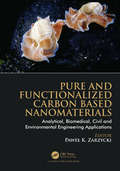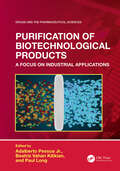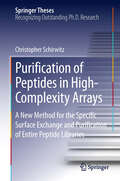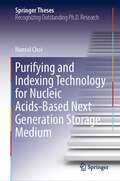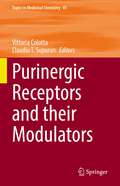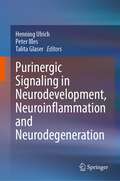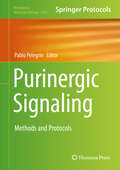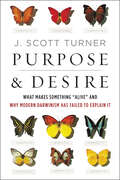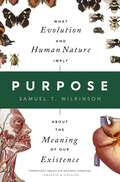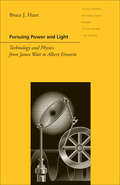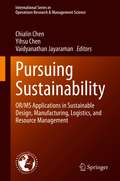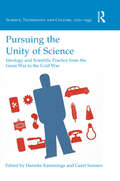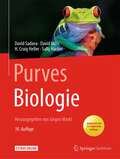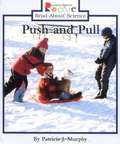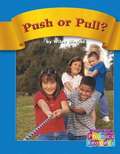- Table View
- List View
Pumpkin Seed: Newer Perspectives
by Khalid Bashir Kulsum Jan Mehvish Habib Shumaila JanIncreased consumer awareness of the health benefits of foods has led food manufacturers to increasingly focus on the functional ingredients. The functional components found in pumpkin enhance immunity and provide a litany of health benefits for the consumer. Pumpkin is high in proteins, beneficial seed oils and antioxidant properties. Many different types of foods can be developed from pumpkin seed as well. To date there has been no reference work that documents the up-to-date knowledge regarding pumpkin seed its production, structure, health benefits and utilization to develop food products, plus the health benefits, bioavailability and accessibility. Pumpkin Seed: Newer Perspectives addresses the most recent advances and future prospects in pumpkin seed chemistry and valorization of pumpkin byproducts. The text provides researchers with a thorough understanding of new product development, use of protein in food supplementation, packaging films and many other uses. Different extraction techniques, phytochemical composition and applications in food and nutraceuticals are studied in full. Chapters deliver up-to-date information regarding the trends for the development of functional foods through pumpkin byproducts utilizing novel methods and updated technology, serving as a multidisciplinary source for researchers in food science and technology and biotechnology.
Pumps and Pipes
by Alan B. Lumsden Ioannis Kakadiaris Mark G. Davies William E. KlineThe Pumps and Pipes collaboration and conference brings together energy, medicine, and higher education in a unique shared effort, exploring ideas and research common to these important fields and stimulating discussion and sharing technologies that can further the reach and goals of each individual area. The Proceedings explores the common attributes of oil and gas technology, computational sciences and cardiovascular medicine and probe the areas where there is room to cross-fertilize and develop research and commercial programs.
Pumps for Chemical Processing
by J.T. McGuireA reference for the chemical engineer on the application, selection, construction, procurement, installation, operation, and maintenance of the three basic types of pumps used in chemical processing: centrifugal, rotary, and reciprocating. Emphasizes aspects that cause practical operating problems,
Pumps, Channels and Transporters
by Ronald J. Clarke Mohammed A. KhalidDescribes experimental methods for investigating the function of pumps, channels and transporters Covers new emerging analytical methods used to study ion transport membrane proteins such as single-molecule spectroscopy Details a wide range of electrophysiological techniques and spectroscopic methods used to analyze the function of ion channels, ion pumps and transporters Covers state-of-the art analytical methods to study ion pumps, channels, and transporters, and where analytical chemistry can make further contributions
Punctuated Equilibrium
by Stephen Jay Gould"Punctuated Equilibrium" holds that the great majority of species originate in geological moments (punctuations) and persist in stasis. The idea was hotly debated because it forced biologists to rethink entrenched ideas about evolutionary patterns and processes. But as Gould shows here in his typically exhaustive coverage, the idea has become the foundation of a new view of hierarchical selection and macro-evolution.
Punkten in 100 Millisekunden: Ihr Wegweiser für einen starken Auftritt
by Imme Vogelsang Eva Barth-Gillhaus Laura FölmerDieser Leitfaden für eine gelungene Selbstdarstellung bietet neben praktischen Ratschlägen unterhaltsame Ausflüge in wissenschaftliche Forschungsfelder. Studien belegen schon lange, dass Outfit und Auftreten maßgeblicher über Erfolg oder Misserfolg entscheiden als die reine Leistungsfähigkeit oder Fachkompetenz. Vor allem der erste Eindruck bestimmt, was ein Gegenüber vom anderen hält. Es lohnt sich, die Mechanismen zu kennen und anzuwenden: Persönliche Ausstrahlung und souveränes Auftreten sind für den Erfolg gerade im digitalen Zeitalter wichtiger denn je.Die Autorinnen verbinden praktische Ratschläge und Beispiele der Bereiche Kommunikation, Körpersprache und Kleidung mit soliden Ergebnissen z. B. der Hirnforschung. Sie erfahren, wie Sie vom ersten Moment an besser wahrgenommen werden und in unterschiedlichen Alltags und Business-Situationen mehr Wirkung ausstrahlen – übrigens auch bei Videokonferenzen auf dem Bildschirm. Die 2. Auflage wurde überarbeitet und um ein Kapitel zur neuen Lockerheit ergänzt.
Puppy Kindergarten: The New Science of Raising a Great Dog
by Brian Hare Vanessa WoodsThe New York Times bestselling authors of The Genius of Dogs take us into their &“Puppy Kindergarten&” at Duke University, a center to study how puppies develop, to show us what goes in to raising a great dog.Don&’t miss Brian Hare and Vanessa Woods in Netflix&’s film Inside the Mind of a Dog! &“A firehose of knowledge suffused with levity and charm.&”—Alexandra Horowitz, author of Inside of a DogWhat does it take to raise a great dog? This was the question that husband-and-wife team Brian Hare and Vanessa Woods hoped to answer when they enrolled one hundred and one puppies in the Duke Puppy Kindergarten. With the help of a retired service dog named Congo, Brian, Vanessa, and their team set out to understand the secrets of the puppy mind: What factors might predict whether a puppy will grow up to change someone&’s life?Never has cuteness been so cutting edge. Applying the same games that psychologists use when exploring the development of young children, Hare and Woods uncover what happens in a puppy&’s mind during their final stage of rapid brain development. Follow the adventures of Arthur, who makes friends with toy dinosaurs; Wisdom, the puppy genius; and Ying, who fails at cognitive games that even pigeons usually pass with flying colors. Along the way, learn about when puppies finally start to retain memories for longer than just a few seconds, or when they finally develop some self-control.Raising dozens of puppies on a college campus means you get pretty good at answering big questions, such as: When do puppies sleep through the night? How do you stop them from eating poop? How can we help our puppies grow up to be the best dogs they can possibly be? Whether you are a new puppy parent or a perennial puppy lover, Puppy Kindergarten will answer every question you&’ve ever had about puppies—and some you never thought to ask.
Pura Química
by Adela Muñoz PáezUn ingenioso recorrido por las partículas que nos han cambiado la vida. Antes de que el bótox revolucionara la estética fue utilizado como arma de guerra. Las pinturas rupestres se hicieron con el mismo compuesto básico que las actuales cremas solares. Las luces de Navidad emiten un mensaje similar al de los machos de las luciérnagas. El arsénico fue usado primero en las paredes de las casas acaudaladas que como artefacto mortal. Y ya en documentos sumerios aparecían referencias al té de sauce, en el que Bayer se fijaría para patentar la aspirina. Adela Muñoz Páez traza el camino entre pasado y presente a través de las partículas, átomos y moléculas que han configurado nuestro día a día. Con un estilo ameno, pero riguroso, acerca en esta serie de artículos la ciencia pura a lectores ávidos del más elemental de los conocimientos. «Los seres humanos somos capaces de pensar, sentir, vivir, gracias a una infinidad de reacciones químicas que tienen lugar en nuestros cuerpos. Por eso no tiene ningún sentido hablar de lo natural frente a lo químico, porque nosotros, como todos los seres vivos, somos química, pura química».
Pure Human: The Hidden Truth of Our Divinity, Power, and Destiny
by Gregg BradenIn an age where technologies such as AI threaten to supplant human intelligence, an award-winning scientist offers a radical new view of our innate human technology and what we're truly capable of.There are rare moments in time when we make choices that irreversibly change the world, and our lives, forever. Today is one of those moments.Scientists, engineers and philosophers alike warn us that without a radical shift in our thinking, we are on track to be the last generation of pure humans that the world will know. Within a single generation we will devolve into a hybrid species of synthetic bodies, Artificial Intelligence (AI), and computer chips that limit our ability to think, to love, and to adapt to the conditions of the emerging world in a healthy way. In doing so we will also lose our capacity for emotion, empathy, intimacy, and forgiveness—the very qualities that we value and cherish in our humanness.The question that we face is simple: Do we love ourselves enough to preserve the gift of our humanness? Our answer is based upon the way we&’ve been taught to think of ourselves.This book is a compelling journey of self-discovery that will catapult you beyond conventional thinking when it comes to your origins, your limits and, most importantly, the abilities that have been hidden from you for centuries, and the extraordinary potential that awaits as you embrace them.
Pure and Functionalized Carbon Based Nanomaterials: Analytical, Biomedical, Civil and Environmental Engineering Applications
by Paweł K. ZarzyckiThis book describes in a comprehensive manner latest studies conducted by various research groups worldwide focusing on carbon and related nanomaterials. Fourteen chapters of this book deal with a number of key research topics and applications of pure and functionalized carbon nanomaterials and their hybrid nanocomposites. Specifically, the authors have presented interdisciplinary investigations including: (i) carbon nanoparticles and layers synthesis, (ii) analytical aspects of carbon nanomaterials and their characterisation under different conditions as well as (iii) various applications of carbon nanoparticles. They have reported and summarised key applications of carbon particles or nanoobjects in pharmacy, biomedicine, agriculture and food industry, water treatment, physicochemical analysis, optoelectronics, electronic and magnetic materials for supercapacitors or radar adsorbing materials, tribology, chromatography, electrophoresis, bioanalysis, nanobiocatalysis, biofuels production as well as environmental remediation.
Purification of Biotechnological Products: A Focus on Industrial Applications (ISSN)
by Paul Long Pessoa Jr. Adalberto Beatriz Vahan KilikianThis outstanding text focuses on providing professionals and students working in the pharmaceutical and biotechnology field with the background necessary for developing of a product or process and with the necessary rigor required by federal regulatory agencies in the pharmaceutical industry. The material will enable teachers, lecturers and professors in biotechnology to prepare courses on basic concepts and applications for the purification of biotechnological products of industrial interest. These can be applied in practice, for example, with projects on purification development on an industrial scale or useful unit operations for the development of bioproducts of commercial interest.Features: Purification and development of new bioproducts and improvement of those being produced. Provides a background and concepts on the purification of biomolecules and with an industrial perspective. It allows professionals to understand the entire process of developing a biopharmaceutical or bio-food, from bench to industry in biotechnology; one of the fastest-growing sectors of the economy. It promotes the dissemination of information in a didactic way which is of paramount importance for interdisciplinary fields It enables the reader to follow step-by-step stages of the development of a new biopharmaceutical, and allows the optimization of existing processes.
Purification of Peptides in High-Complexity Arrays: A New Method for the Specific Surface Exchange and Purification of Entire Peptide Libraries
by Christopher SchirwitzChristopher Schirwitz's thesis focuses on improving the quality of in situ synthesized high-complexity peptide micro arrays. Micro arrays containing proteins or small protein fragments in the form of peptides have become of great interest in proteomic research. With the help of these microarrays a large number of potential target molecules can be screened for interaction with a probe in a short timeframe. However, protein and peptide micro arrays are still lagging behind oligonucleotide arrays in terms of density, quality and manufacturing costs. A new approach developed at the German Cancer Research Center (DKFZ) has improved the synthesis of high-density peptide arrays. The current technology is capable of producing arrays with up to 40,000 different peptides per square cm by means of micro particle-based solid phase peptide synthesis. However, in situ synthesis approaches bear a conceptual disadvantage: The quality of the peptides is dependent on the efficiency of the synthesis so that peptide fragments are present in the resulting array among the desired full-length peptides. In peptide-protein interaction studies such peptide fragments. The central achievement of this thesis is the development of a new method allowing for the fast one-step purification of entire arrays without loss of resolution or spatial information. Christopher Schirwitz's work has resulted in a number of publications in high ranking journals.
Purifying and Indexing Technology for Nucleic Acids-Based Next Generation Storage Medium (Springer Theses)
by Hansol ChoiThis book introduces novel purification technology for the complex oligonucleotide libraries. Since the concept of synthesizing oligonucleotides (oligos) has been proposed, research fields such as nucleic acid-based therapies (CRISPR-Cas9, DNA/RNA vaccines, RNAi), synthetic biology, protein engineering, and DNA-based data storage have bloomed. The COVID-19 pandemic underscores the potential of nucleic acid-based technologies, such as vaccines or diagnostics. As they emerge as the most promising weapons against the current pandemic, increasing need for highly accessible nucleic acid purification technologies is expected. To meet this demand, an oligo purification technology that can be applied to complex oligo libraries and can purify oligos with single-base resolution is developed. In addition, the purification technology can be applied to highly complex oligo libraries of different lengths, enabling the simultaneous purification of complex oligo libraries with different lengths. The proposed technology can be easily accessed by users and would help accelerate numerous research fields that utilize oligos as fundamental building blocks.
Purinergic Receptors and their Modulators (Topics in Medicinal Chemistry #41)
by Claudiu T. Supuran Vittoria ColottaThis book overviews purinergic receptors that are playing key roles in human and pathophysiological processes. The book elaborates on how selective P1 and P2 modulators have been developed as therapeutics for a variety of diseases. It also provides an overview of current perspectives in the design of purinergic receptor modulators and future challenges such as the availability of selective ligands for all receptor subtypes.Divided into 12 chapters, this comprehensive volume also offers a multidisciplinary perspective on the historical evolution, starting with a chapter devoted to the roots and early discoveries of adenosine and its receptors, followed by a twenty-year retrospective on the synthesis, properties, and functional potential of adenosine receptor ligands, probes, and functional conjugates. In the next chapters, experts in the field delve into topics such as the therapeutic potential of adenosine receptor ligands in wound healing and fibrosis, the therapeutic benefits of A2A receptor antagonists, the A2B adenosine receptor as a target for brain ischemia or demyelination, the development and latest advancements in clinical trials of A3 adenosine receptor ligands. Other chapters describe bifunctional tools to study adenosine receptors, allosteric modulators of adenosine receptors, and new computational approaches to inspect adenosine receptor-ligand recognition processes. Furthermore, the book discusses the role of P2X4 receptors in immunity and inflammation. The final chapters illustrate CD73 inhibitors as antitumor agents, and bacterial ectonucleotidases as underexplored antibacterial drug targets. This book is a valuable resource for scholars working in the field of medicinal chemistry, as well as researchers in the industry, providing readers with a comprehensive understanding of adenosine receptor biology and its therapeutic potential.
Purinergic Signaling in Neurodevelopment, Neuroinflammation and Neurodegeneration
by Henning Ulrich Peter Illes Talita GlaserThis volume explores the quickly evolving field of Purinergic signaling, and examines how receptors for ATP and other nucleotides, and receptors for adenosine, act in neuronal transmission, control of synaptic activity, proliferation, differentiation and cell death regulation in the CNS. This book focuses on the participation of purinergic receptors and ectonucleotidases, degrading ATP into adenosine, in embryonic and adult neurogenesis in vitro and in vivo as well as in synaptic transmission and pathophysiology. Further, the chapters discuss varying brain diseases, including Parkinson’s, and Alzheimer’s disease, autism, mood disorders and epilepsy, as well as brain tumors, in the context of purinergic signaling and its clinical aspects. The development of purinergic receptor agonists is also an important issue of this book. This book provides a critical review of the current state of science and will be useful for both scientists and students who are or would like to get involved in this area. Furthermore, this book addresses neuroscientists, physician and professionals from the industry, who would like to update themselves in this exciting and rapidly growing field of neuroscience.
Purinergic Signaling: Methods and Protocols (Methods in Molecular Biology #2041)
by Pablo PelegrínThis volume aims to cover all major methodological aspects of research into purinergic signaling and to provide a foundation for studying them at molecular, biochemical, pharmacological, and physiological levels. Chapters guide readers through current knock-out and knock-in mouse models, in silico modeling, knock down purinoceptor expression, bioluminiscence resonance energy transfer, enzyme-based biosensors, recording P2X receptor electrophysiology, controlling P2X receptors by optogenetics, inflammasome activation, leukocyte migration, and cell adhesion. Written in the highly successful Methods in Molecular Biology series format, chapters include introductions to their respective topics, lists of the necessary materials and reagents, step-by-step, readily reproducible laboratory protocols, and tips on troubleshooting and avoiding known pitfalls. Authoritative and cutting-edge, Purinergic Signaling: Methods and Protocols will provide a sound basis for molecular, cellular, and physiological research into purinergic signaling in health and disease and will spark interest in this fascinating signaling process among researchers in many different and unrelated disciplines.
Purple Pinchers and Other Hermit Crabs (World Book's Animals of the World)
by Sheri RedaTopics in the book include how to care for a hermit crab, how it transfers from house to house, and how to care for one as a pet.
Purpose & Desire: What Makes Something "Alive" and Why Modern Darwinism Has Failed to Explain It
by J. Scott TurnerCan biology define life? “[An] ingenious mixture of science and philosophy. . . . highly thought-provoking.” —Kirkus Reviews (starred review)In this book a professor, biologist, and physiologist argues that modern Darwinism’s materialist and mechanistic biases have led to a scientific dead end, unable to define what life is—and only an openness to the qualities of purpose and desire will move the field forward.As Scott Turner contends: “To be scientists, we force ourselves into a Hobson’s choice on the matter: accept intentionality and purposefulness as real attributes of life, which disqualifies you as a scientist; or become a scientist and dismiss life’s distinctive quality from your thinking. I have come to believe that this choice actually stands in the way of our having a fully coherent theory of life.”Growing research shows that life’s most distinctive quality, shared by all living things, is purpose and desire: maintain homeostasis to sustain life. In Purpose and Desire, Turner draws on the work of Claude Bernard, a contemporary of Darwin revered among physiologists as the founder of experimental medicine, to build on Bernard’s “dangerous idea” of vitalism, which seeks to identify what makes “life” a unique phenomenon of nature. To further its quest to achieve a fuller understanding of life, Turner says, science must move beyond strictly accepted measures that consider only the mechanics of nature. A thoughtful appeal to widen our perspective of biology that is grounded in scientific evidence, Purpose and Desire helps us bridge the ideological evolutionary divide.“A must-read for everybody interested in the science of life and evolution . . . one of those rare science books which inquisitive laypeople will equally enjoy. Purpose and Desire will change the way you think of life.” —Washington Book Review“[A] beautifully written book, brimming with anecdotes and biological insights . . . will leave readers moved by Turner’s deep appreciation of life’s exquisiteness, its richness, and diversity . . . a provocative thesis, but one that is a wonderfully rich read, thought-provoking, and highly recommended.” —The Quarterly Review of Biology
Purpose: What Evolution and Human Nature Imply about the Meaning of Our Existence
by Samuel T. WilkinsonBy using principles from a variety of scientific disciplines, Yale Professor Samuel Wilkinson provides a framework for human evolution that reveals an overarching purpose to our existence. Generations have been taught that evolution implies there is no overarching purpose to our existence, that life has no fundamental meaning. We are merely the accumulation of tens of thousands of intricate molecular accidents. Some scientists take this logic one step further, suggesting that evolution is intrinsically atheistic and goes against the concept of God. But is this true? By integrating emerging principles from a variety of scientific disciplines—ranging from evolutionary biology to psychology—Yale Professor Samuel Wilkinson provides a framework of evolution that implies not only that there is an overarching purpose to our existence, but what this purpose is. With respect to our evolution, nature seems to have endowed us with competing dispositions, what Wilkinson calls the dual potential of human nature. We are pulled in different directions: selfishness and altruism, aggression and cooperation, lust and love. When we couple this with the observation that we possess a measure of free will, all this strongly implies there is a universal purpose to our existence. This purpose, at least one of them, is to choose between the good and evil impulses that nature has created within us. Our life is a test. This is a truth, as old as history it seems, that has been espoused by so many of the world&’s religions. From a certain framework, these aspects of human nature—including how evolution shaped us—are evidence for the existence of a God, not against it. Closely related to this is meaning. What is the meaning of life? Based on the scientific data, it would seem that one such meaning is to develop deep and abiding relationships. At least that is what most people report are the most meaningful aspects of their lives. This is a function of our evolution. It is how we were created.
Pursuing Power and Light: Technology and Physics from James Watt to Albert Einstein (Johns Hopkins Introductory Studies in the History of Science)
by Bruce J. HuntIn the nineteenth century, science and technology developed a close and continuing relationship. The most important advancements in physics—the science of energy and the theory of the electromagnetic field—were deeply rooted in the new technologies of the steam engine, the telegraph, and electric power and light. Bruce J. Hunt here explores how the leading technologies of the industrial age helped reshape modern physics.This period marked a watershed in how human beings exerted power over the world around them. Sweeping changes in manufacturing, transportation, and communications transformed the economy, society, and daily life in ways never before imagined. At the same time, physical scientists made great strides in the study of energy, atoms, and electromagnetism. Hunt shows how technology informed science and vice versa, examining the interaction between steam technology and the formulation of the laws of thermodynamics, for example, and that between telegraphy and the rise of electrical science.Hunt’s groundbreaking introduction to the history of physics points to the shift to atomic and quantum physics. It closes with a brief look at Albert Einstein’s work at the Swiss patent office and the part it played in his formulation of relativity theory. Hunt translates his often-demanding material into engaging and accessible language suitable for undergraduate students of the history of science and technology.
Pursuing Sustainability: OR/MS Applications in Sustainable Design, Manufacturing, Logistics, and Resource Management (International Series in Operations Research & Management Science #301)
by Vaidyanathan Jayaraman Yihsu Chen Chialin ChenThis handbook includes three parts, corresponding to the following three domains of OR/MS research related to sustainability: (i) Systems Design, Innovation, and Technology, (ii) Manufacturing, Logistics, and Transportation, and (iii) Sustainable Natural Resource Management. The first part of the handbook (Chapters 2-6) will focus on the creation and development of sustainable products, services, value chains, and organizations from a systems perspective. Key areas to be covered include Green Design & Innovation, Technology and Engineering Management, Sustainable Value Chain Systems, Sustainability Standards and Performance Evaluation, and Circular Economy and New Research Directions in Sustainability. The second part of the handbook (Chapters 7-11) will concentrate on the major operational and logistic issues faced by today’s industries in pursuing sustainability. Key areas to be covered include Remanufacturing, Reverse Logistics, Closed-Loop Supply Chains, Sustainable Transportation, and New Research Directions in Green Supply Chain Management. The third part of the proposed handbook (Chapters 12-16) will center on major sustainability issues in managing engineering infrastructure and natural resources. Key areas to be covered include Renewable Energy, Sustainable Water Resource, Biofuel Infrastructure, Natural Gas, and New Research Direction in Sustainable Resource Management.The handbook aims to bridge the three main OR/MS research domains in sustainability: “Systems Design, Innovation, and Technology,” “Manufacturing, Logistics, and Transportation,” and “Sustainable Natural Resource Management.” Traditionally, these domains are treated separately in the OR/MS literature. By combining the three domains, the handbook will provide a more holistic treatment of MS/OR methodologies to address critical sustainability issues faced by today’s society. Unlike most existing handbooks which only focus on current OR/MS research in sustainability within a domain, this handbook will include a concluding chapter in each of the three parts to discuss and identify potential future research directions in each of the three main domains.
Pursuing the Unity of Science: Ideology and Scientific Practice from the Great War to the Cold War (Science, Technology and Culture, 1700-1945)
by Harmke Kamminga Geert SomsenFrom 1918 to the late 1940s, a host of influential scientists and intellectuals in Europe and North America were engaged in a number of far-reaching unity of science projects. In this period of deep social and political divisions, scientists collaborated to unify sciences across disciplinary boundaries and to set up the international scientific community as a model for global political co-operation. They strove to align scientific and social objectives through rational planning and to promote unified science as the driving force of human civilization and progress. This volume explores the unity of science movement, providing a synthetic view of its pursuits and placing it in its historical context as a scientific and political force. Through a coherent set of original case studies looking at the significance of various projects and strategies of unification, the book highlights the great variety of manifestations of this endeavour. These range from unifying nuclear physics to the evolutionary synthesis, and from the democratization of scientific planning to the utopianism of H.G. Wells's world state. At the same time, the collection brings out the substantive links between these different pursuits, especially in the form of interconnected networks of unification and the alignment of objectives among them. Notably, it shows that opposition to fascism, using the instrument of unified science, became the most urgent common goal in the 1930s and 1940s. In addressing these issues, the book makes visible important historical developments, showing how scientists participated in, and actively helped to create, an interwar ideology of unification, and bringing to light the cultural and political significance of this enterprise.
Purves Biologie
by David Sadava H. Craig Heller David M. Hillis Sally D. HackerNeu im Purves: Evolution erheblich erweitertZoologie-Kapitel und -Glossar (neu!) durch Mitarbeit von Mary Berenbaum verbessertWeb-Links "Animated Tutorial" und "Web Activity" verweisen auf kostenfreie seite www.thelifewire.comAnzahl der Boxen "Experiment" sind deutlich erweitert Strukturierung erheblich verbessert durch Schlüsselsätze, Boxen zur "Wiederholung", "Kapitelüberblick" und "Kapitel-Zusammenfassung" sowie Fragen zur Selbstkontrolle70% neue Kapitel-Eröffnungenalle Texte von Biologie-Dozenten kritisch durchgesehen
Push And Pull
by Patricia J. MurphyThis Rookie Read-About Science book introduces kids to pushing and pulling. Colorful photos and simple text encourage children to read on their own as they learn about these forces and how they affect the movement of different objects.
Push Or Pull?
by Wiley BlevinsDiscusses forces such as push or pull in an easy-to-read text that incorporates phonics instruction and rebuses.
